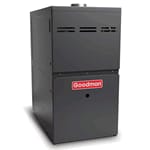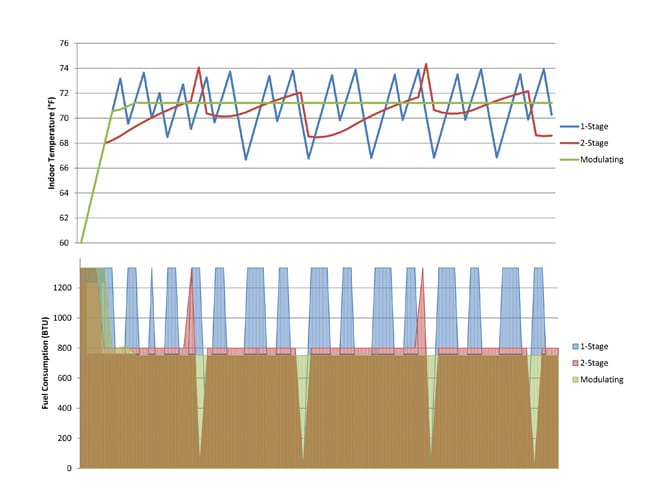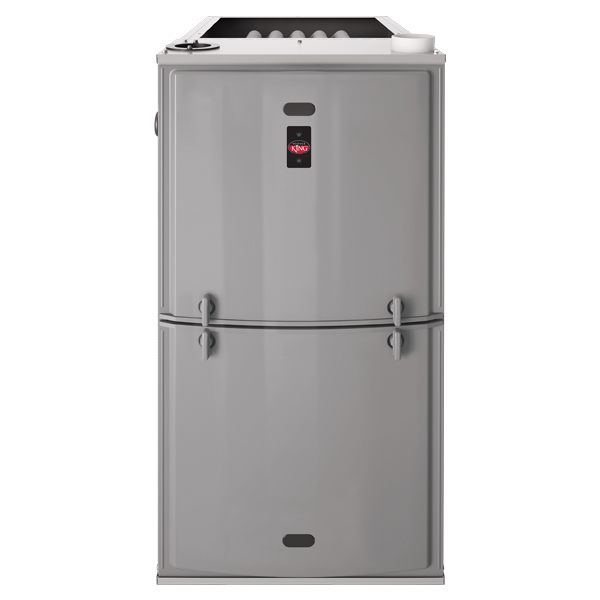
Furnace Buying Guide
The heart of nearly every forced air heating system is the furnace. Gas furnaces come in a variety of sizes, types, and efficiencies to satisfy almost any application.
Our furnace buyer's guide is designed to help you find the best furnace for your home!
Basic Design
 All boilers include three main functional components.
All boilers include three main functional components.
Oil, propane, and natural gas furnaces use a burner to combine fuel and air and then burn this mixture to produce heat.
In all furnaces, a heat exchanger transfers this heat to the air. In electric furnaces, the heat exchanger also converts the electricity into heat. Finally, a blower distributes this warmed air throughout the house.
Be sure to read our guide on how furnaces work for more details.
Burner Options
Furnace burners are designed to operate in one of three ways: single-stage, two-stage, and modulating.
 | Single-Stage Furnace | 2-Stage Furnace | Modulating Furnace |
|---|---|---|---|
| Burner Modes | Off, High-Fire | Off, Low-Fire, High-Fire | Variable |
| Comfort | |||
| Cost | $$ | $$$ | $$$$$ |
| Who It's For | Those on a budget Rental properties Consistently cold climates | Cold climates Zoned heating systems | Mild climates Energy-efficient buildings Zoned heating systems Those needing highly consistent airflow |
| Who It's Not For | Mild climates Energy-efficient buildings Zoned heating systems Those needing highly consistent airflow | Mild climates Energy-efficient buildings
| Those on a budget |
Single-Stage
The first and simplest is a single-stage burner. A furnace using a single-stage burner has only two operating modes, on or off. Single-stage furnaces will always operate at the rated capacity regardless of conditions inside or outside of the home. This can lead to lower efficiency when outside temperatures are mild.
Two-Stage
Two-stage burners address the inefficiency inherent with single-stage burners. A furnace using a two-stage burner has a total of three heating modes, off, low-fire, and high-fire.
High-fire means the furnace is operating at its full rated capacity.
Low-fire is an intermediate step that allows the furnace to operate at less than its maximum capacity. This level is typically 40%-60% of the rated capacity and allows the furnace to better match a home’s heating needs in mild weather. This leads to a more comfortable home, and a lower fuel bill.
Modulating
Expanding on the benefits of two-stage burners, modulating burners can operate at almost any output. Modulating furnaces have a minimum and maximum heating capacity but can operate at almost any point within this range.
By monitoring conditions and adjusting their output, modulating furnaces are able to eliminate large temperature swings sometimes present with other types of furnaces. This adjustability also allows modulating furnaces to operate efficiently across a wide-range of outdoor temperatures and heating loads.
Two-Stage vs Modulating Performance
The charts below show a simulation of average temperature and fuel usage for single-stage, two-stage, and modulating furnaces. As you can see, the two-stage and modulating furnaces maintain a more stable temperature than does the single-stage unit.
The two-stage and modulating options also offer savings of approximately 8% and 10%, respectively, when compared to a single-stage model, even when all three have the same rated efficiency.
Blower Options
Furnace blowers have different speeds that impact how quickly they blow air through your space. They come in two main varieties: multi-speed, and variable-speed.
 | Multi-Speed Blower | Variable Speed Blower |
|---|---|---|
| Comfort | ||
| Efficiency | ||
| Cost | $$$ | $$$$$ |
| Who It's For | Basic zoning applications Cabins & seasonal dwellings | Energy-efficient buildings Zoned heating systems Those needing highly consistent airflow |
| Who It's Not For | Zoned heating systems | Those on a budget |
A multi-speed blower allows the installer to select the appropriate speed for each type of operation at the time of installation. For example, you might want medium speed for heating, but, if your system includes air conditioning, you might need high speed for cooling.
These speeds are fixed for associated operating conditions. The blower does not respond to changes in operation, such as dampers opening in a zoned system or a filter gradually becoming clogged.
Like with a multi-speed blower, an installer sets the operating conditions for a variable-speed blower at the time of installation. However, instead of picking a speed that provides the approximate air flow rate desired, the speeds on variable speed often correspond to a specific air flow rate.
The furnace then monitors flow rates, temperatures, and other information and adjusts the blower operation to maintain ideal operating conditions. This allows variable-speed blowers to respond to changes in conditions and provide optimal comfort, especially when paired with a modulating burner.
Orientation Options
Furnaces come in a variety of orientations to satisfy different installation conditions. The most common orientations available include upflow, downflow, horizontal, and low-boy.
Some furnaces support several different orientations. These are often called multi-position or list the possible orientations, e.g. upflow-horizontal.
 | Upflow | Downflow | Horizontal | Low-Boy |
|---|---|---|---|---|
 |  |  |  | |
| Description | Air Enters the Bottom, Flows Out the Top | Air Enters the Top, Flows Out the Bottom | Air Enters One Side, Flows Out Other Side | Air Enters and Flows Out the Top |
| Cost | $$ | $$$ | $$ | $$$$ |
| Who It's For | Anywhere ductwork is above the furnace, i,e, basements, closets | Anywhere ductwork is below the furnace, i.e. crawlspaces, Mobile Home | Anywhere with limited vertical space, i.e. attics, crawl spaces, closets | Older or historic homes |
Upflow Orientation
In an upflow furnace, the air enters the furnace near the bottom and exits after being heated at the top. The return air connection can be located on either the bottom of the furnace or on either the left or right side of the blower compartment.
Upflow systems are commonly used when the furnace is installed in the basement or in a closet, with the ductwork overhead.
Downflow Orientation
Downflow furnaces have a return connection near the top of the furnace and supply heated air out the bottom of the furnace. Return air is typically routed directly to the top of the unit.
Downflow furnaces are used in applications where ductwork is installed below the furnace. This is common in homes with ductwork installed in a crawlspace or in commercial buildings where ductwork is in the slab.
Horizontal Orientation
Horizontal furnaces typically have a return connection at one end and a supply connection at the opposite end, with both connecting horizontally.
Horizontally-oriented furnaces are typically used in attics, crawlspaces, and other areas with limited height.
Low-Boy Orientation
Low-boy furnaces have both supply and return connections at the top of the furnace. This design results in a shorter but wider unit.
Low-boy furnaces were common in older homes but are being gradually replaced with other types of units. An upflow or horizontal furnace is often a suitable replacement for a lowboy model, but the ductwork will need to be modified.
Venting Options
Furnaces have two primary venting configurations: chimney and direct venting.
 | Chimney/Draft Induced Venting | Direct Venting |
|---|---|---|
| Operation | Intake air pulled from inside, exhaust vented through chimney | Intake air pulled from outside, exhaust vented through wall |
| Efficiency | Average | High |
| Cost | $$ | $$$$ |
| Who It's For | Homes with chimneys Historic homes Those on a Budget | Homes without a chimney Applications where intake air is dirty, like a basement workshop New construction Energy efficient homes |
| Who It's Not For | Homes without a chimney Applications where intake air is dirty, like a basement workshops Energy efficient homes | Those on a Budget |
Chimney-vented furnaces have large vent connections and rely on the natural buoyancy of hot air to exhaust combustion gasses and draw fresh air into the furnace. To make sure this process is working correctly, they require large chimneys. Chimney-vented furnaces are rarely available in efficiencies exceeding 80% AFUE.
Direct-vented furnaces are more efficient and exhaust either vertically through a ceiling or horizontally through a side wall. They use smaller venting than chimney-vented furnaces and pull fresh air directly from outside rather than the indoor space.
Pulling outdoor air is more efficient because the furnace isn't removing warm air from inside your home. This makes direct-vented furnaces the best option for installations inside the living areas of a home. Furthermore, outdoor air can be cleaner and better for your furnace than indoor air, especially if your furnace is in an area where you work with wood or chemicals.
Efficiency (AFUE)
 Furnace efficiency is measured by the annual fuel utilization efficiency (AFUE). AFUE can range between 80% (the federally mandated minimum) to 97%.
Furnace efficiency is measured by the annual fuel utilization efficiency (AFUE). AFUE can range between 80% (the federally mandated minimum) to 97%.
Most manufacturers continue to offer basic single-stage, multi-speed, 80% AFUE models for the budget-minded consumer. However, models with AFUE rates of 90% or higher are becoming more and more common. In some instances, government mandates require higher AFUE ratings in cold climates.
Models with AFUE rates of 90% or higher use condensing technology to capture as much of the heat available from combustion as possible. This process releases a substantial amount of energy that can then be used to heat your home. The condensing process produces condensate water, which must be treated and drained.
The AFUE rating is a great way to compare energy efficiency between models, but may not accurately reflect the efficiency of the unit once it is installed.
Duct sealing, insulation, and routing, as well as filters and humidifiers, can all impact operational efficiency. It is important to address any existing issues in these components to ensure your system can operate at peak efficiency and keep your home comfortable.z
How Much Does a New Furnace Cost?
An average furnace with installation can cost between $3,000 and $6,000 or more, depending on the type of furnace, location, and installer. For example, installation costs are higher in markets like Los Angeles than they are in Detroit. Furthermore, the output, fuel type, features, efficiency, staging options, and overall complexity of the furnace will also impact your final cost.
For personalized furnace cost estimates, please reach out to one of our furnace experts today.
Stay Warm
Now that you know how furnaces work and the different kinds available, you're ready to check some out for yourself. Remember, you can contact the team at eComfort with any further questions.





